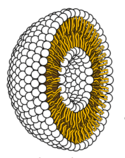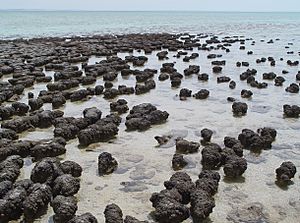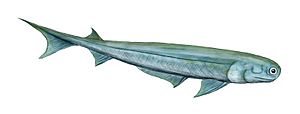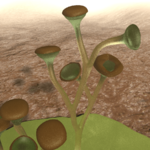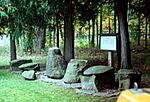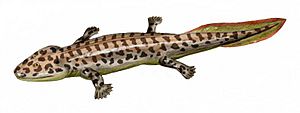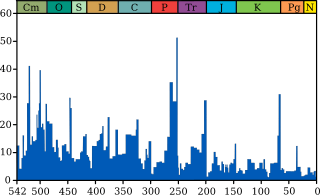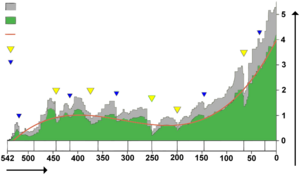History of life facts for kids
The history of life on Earth tells the story of how living things, from the very first tiny cells to all the plants and animals we see today, have changed and developed over billions of years. Our planet formed about 4.5 billion years ago. Scientists believe that life first appeared on Earth more than 3.7 billion years ago. All living things on Earth today are related and have slowly changed over time from a common ancestor. This process is called evolution.
The oldest clear signs of life are found in rocks from Greenland, about 3.7 billion years old. These include special carbon patterns and fossils called stromatolites, which are made by tiny living things. Even older signs, possibly 4.1 billion years old, were found in Australia. Some scientists even think life might have started as early as 4.28 billion years ago near hydrothermal vents in the ocean, not long after the oceans themselves formed. However, these very early signs are still being studied to make sure they are truly from living things.
Tiny living things like bacteria and archaea (another type of tiny cell) were the main forms of life for a very long time. They lived in groups called microbial mats. A huge step in life's history was when cyanobacteria (blue-green algae) developed photosynthesis around 3.5 billion years ago. This process uses sunlight to make food and releases oxygen as a waste product. Over a long time, this oxygen built up in the oceans and then in the atmosphere, leading to the Great Oxygenation Event about 2.4 billion years ago. This changed Earth forever.
More complex cells, called eukaryotes, appeared around 1.85 billion years ago. These cells have special parts inside them, like a nucleus and mitochondria. Mitochondria help cells use oxygen to get lots of energy. This was a big advantage in the new oxygen-rich world. Later, some eukaryotes also gained the ability to photosynthesize, becoming the ancestors of algae and eventually plants.
Around 1.7 billion years ago, multicellular organisms began to appear. These organisms are made of many cells that work together and have different jobs. While early life often reproduced by simply splitting in two (asexually), most complex organisms today, including animals and plants, use sexual reproduction. This involves combining genetic material from two parents to create new offspring. How sexual reproduction first evolved is still a mystery, but it's very important for creating variety in living things.
Even before complex plants, tiny living things formed the first land ecosystems about 2.7 billion years ago. Land plants, which evolved from freshwater green algae, appeared much later, around 1 billion years ago. Plants became very successful on land. Their growth even affected Earth's climate, possibly leading to an ice age and changes in ocean chemistry that caused some extinctions.
Animals with left and right sides that are mirror images, called Bilateria, appeared about 555 million years ago. Most modern animal groups, including vertebrates (animals with backbones), first appeared during the Cambrian explosion about 525 million years ago. Later, during the Permian period, mammal-like reptiles called synapsids were common on land.
A huge event called the Permian–Triassic extinction event happened 252 million years ago, wiping out most complex species. After this disaster, dinosaurs became the main land animals during the Jurassic and Cretaceous periods. But then, another big event, the Cretaceous–Paleogene extinction event, happened 65 million years ago, which killed off the non-bird dinosaurs. After this, mammals quickly grew in size and variety. These mass extinctions, though terrible, often opened up opportunities for new groups of organisms to evolve and spread.
Scientists believe there could be 1 trillion species on Earth, but only about 1.75 to 1.8 million have been named. The species alive today are less than one percent of all the species that have ever lived on Earth!
Orange labels: known ice ages.
Also see: Human timeline and Nature timeline
Contents
Earth's Early Days
The Earth is about 4.54 billion years old. Scientists figured this out by studying ancient rocks and meteorites. Many scientists think that about 40 million years after Earth formed, a Mars-sized object crashed into it. This crash threw material into space, which then formed the Moon.
Until recently, scientists thought Earth's surface was molten (liquid rock) for a very long time. They called this early period the Hadean. However, newer studies of tiny crystals called zircons show that Earth's crust hardened much faster, about 4.4 billion years ago. This means oceans and an atmosphere formed quickly, possibly making Earth ready for life sooner than thought.
The Moon shows signs of a "Late Heavy Bombardment" between 4 and 3.8 billion years ago, when many space rocks crashed into it. Earth, being larger, would have been hit even more. This event might have stripped away Earth's early atmosphere and oceans. But if tiny life forms were already living deep underground, they might have survived this bombardment.
First Signs of Life on Earth
The very first living things were tiny and simple. Their fossils look like small rods, which are hard to tell apart from non-living rock formations. The oldest clear evidence of bacteria fossils is from 3 billion years ago. Some scientists have found signs in rocks from 3.5 billion years ago that they believe are bacteria. However, it's tricky because non-living processes can sometimes create similar patterns. So, these older findings are still debated.
Some scientists have also found possible fossilized microorganisms in Canada that could be between 3.77 and 4.28 billion years old. But again, this evidence is still being discussed and isn't fully proven.
How Life Began on Earth
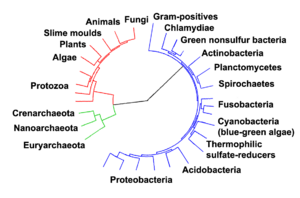
Many biologists believe that all living things on Earth came from a single last universal ancestor. This is because it would be very hard for life to have started more than once, with all the complex chemical systems that are the same in every living thing.
Another idea is that there wasn't just one "first cell." Instead, early life might have been a mix of different "pre-cells" that slowly became more organized. From this mix, the first cells of the three main groups of life (bacteria, archaea, and eukaryotes) appeared one after another.
Life Starting on Earth
Life on Earth is based on carbon and water. Carbon is great for building complex chemicals, and it's easy to find. Water is an excellent liquid for chemicals to mix in. It also has special properties, like ice floating, which helps water life survive in winter. Other chemicals aren't as good as carbon and water for supporting life.
Scientists studying how life began from non-living chemicals look at three main things:
- Self-replication: How organisms make copies of themselves.
- Metabolism: How organisms get energy and repair themselves.
- Cell membranes: Outer coverings that let good things in and keep bad things out.
Scientists are still working on how these things first came together.
The RNA World Idea
Today, living things use DNA to store their instructions and RNA and proteins to read them. But scientists found that some RNA molecules can do both jobs: copy themselves and help make proteins. This led to the idea of an "RNA world" where early life was based only on RNA. Later, DNA took over for storing instructions because it's more stable. RNA still plays a key role in making proteins in all cells today. Some evidence suggests the first RNA molecules formed over 4.17 billion years ago.
The Membranes First Idea
Another idea is that the first step was the formation of "bubbles" made of lipids, similar to cell membranes. Experiments show that lipids can form these bubbles on their own and even make copies. These bubbles could have protected early chemicals, allowing RNA or other molecules to form more easily inside.
The Clay Idea
Some scientists think that certain types of clay might have helped life begin. Clay can grow by copying its own patterns and can also help form RNA molecules. This idea suggests that clay could have acted like a simple "parent" for early life, helping complex molecules form.
The Metabolism First Idea
Another theory is that life started with simple chemical reactions, or "metabolism," in places like hydrothermal vents deep in the ocean. Experiments show that chemicals like iron sulfide and nickel sulfide can act as catalysts (helpers) for forming basic building blocks of proteins. This suggests that life's chemical processes could have started in these hot, mineral-rich environments.
Where Life Might Have Started
Hot Springs on Land
Some scientists believe life might have started in geothermal springs (hot springs) on land. These places have wet and dry cycles, which can help chemicals combine to form larger molecules needed for life. The temperatures are good for molecules, and minerals in the springs can act as catalysts. Also, sunlight can help create important molecules like RNA parts.
Scientists found that hot springs from 3.5 billion years ago had many elements needed for life, like potassium, boron, and phosphorus. The water in these springs is also similar to the inside of modern cells. Fatty acids, which make up cell membranes, can form bubbles in these freshwater springs during wet-dry cycles. It's thought that organic compounds needed for life might have arrived on Earth from space, carried by meteorites, and then collected in these springs.
Deep Sea Hydrothermal Vents
Another popular idea is that life began at deep-sea hydrothermal vents, also known as "white smokers." These vents release hot, mineral-rich water from inside the Earth. The minerals can act as catalysts for chemical reactions. Scientists have done experiments that copy these conditions and have successfully made short RNA chains and cell-like bubbles.
These vents provide energy from chemical reactions and create natural chemical differences that could power early life. Some studies of the genes of modern tiny organisms suggest that the last universal common ancestor (LUCA) might have lived in a hot, oxygen-free environment like these vents.
Life from Space (Panspermia)
The Panspermia idea suggests that life didn't start on Earth but came here from somewhere else in the Universe. This idea has been around for a long time. It doesn't explain how life started in the first place, just how it got to Earth.
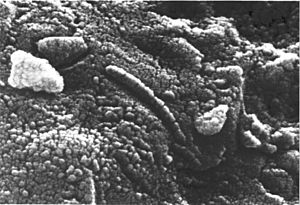
There are a few ways this could have happened:
- From other planets in our Solar System, like Mars, carried on rocks blasted into space by meteor impacts.
- Brought by alien visitors, perhaps by accident.
- Arriving naturally from outside our Solar System.
Experiments show that some tiny living things can survive the harsh conditions of space. A meteorite from Mars, called ALH84001, has structures that some scientists think look like fossilized bacteria.
Carbonate-Rich Lakes
One theory suggests that life began in ancient lakes rich in carbonate. Phosphate is a key ingredient for life, found in DNA and cell energy molecules. But phosphate is usually hard to find in nature because it reacts with calcium and settles out of water.
In carbonate-rich lakes, calcium reacts with carbonate instead, leaving more phosphate available. Early Earth's atmosphere had a lot of carbon dioxide, making rainwater acidic. This acidic rain weathered rocks, bringing more phosphate into these lakes. With high phosphate levels and no tiny organisms using it yet, phosphate could build up to levels needed for life to begin.
Like hot springs, these lakes would have had changing water levels, with wet and dry cycles. This drying could help small molecules combine into larger ones, like those needed for energy storage. When water returned, these new biomolecules could have washed back into the lake, allowing the first steps of life to happen.
The Impact of Microbial Mats
Microbial mats are thin layers of different types of tiny organisms, like bacteria, living together. Each layer has different chemicals, favoring different microbes. They form their own mini "food chains."
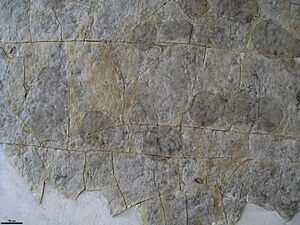
Stromatolites are dome-shaped structures built by these mats as the microbes slowly move upwards to avoid being buried by sediment. Scientists have debated whether very old stromatolite-like fossils were actually made by living things, but some found in Australia from 3.5 billion years ago are widely accepted.
In modern mats, the top layer often has photosynthesizing cyanobacteria that make oxygen. The bottom layer is oxygen-free. Oxygen is harmful to organisms not used to it, but it greatly increases energy production for those that are. When cyanobacteria started making oxygen from water, it was a huge boost for life.
Oxygen became a major part of Earth's atmosphere about 2.4 billion years ago. This was necessary for the evolution of complex eukaryotic cells, which make up all multicellular organisms. The changing oxygen levels in microbial mats might have pushed organisms to learn to tolerate and then use oxygen, perhaps by one organism living inside another (endosymbiosis).
Cyanobacteria are very adaptable and were the first to spread as floating mats and tiny ocean plants (phytoplankton), forming the base of many ocean food chains.
Eukaryotes Become Diverse
Complex Cells and Mitochondria
Eukaryotes are cells with a nucleus and other special parts called organelles. Most modern eukaryotes need oxygen, which their mitochondria use to create energy. Scientists believe eukaryotes formed when one tiny cell (a prokaryote) swallowed another, but instead of eating it, they started living together. For example, a larger prokaryote might have swallowed a smaller one that became the mitochondria. This partnership was so successful that the two cells became one.
Scientists debate when eukaryotes first appeared. Some chemical signs in rocks from 2.7 billion years ago might point to them, but this is still uncertain. However, fossils of algae from 1.85 billion years ago clearly show eukaryotes with organelles. Diverse algae fossils have been found from 1.5 to 1.4 billion years ago, and the oldest known fungi fossils are from 1.43 billion years ago.
Plastids and Photosynthesis
Plastids, like chloroplasts in plants, are organelles that allow cells to perform photosynthesis. They are thought to have come from endosymbiotic cyanobacteria (cyanobacteria living inside another cell). This partnership, which started around 1.5 billion years ago, allowed eukaryotes to make their own food using sunlight. This led to the evolution of green algae, red algae, and other photosynthetic organisms.
Sexual Reproduction and Multicellular Life
How Sexual Reproduction Evolved
Sexual reproduction in eukaryotes involves meiosis and fertilization, where genetic material from two parents combines. This creates offspring that are a mix of both parents, leading to more variety. In contrast, asexual reproduction simply makes copies of the parent. Bacteria also share DNA, but it's not the same as sexual reproduction.
Sexual reproduction has some downsides: it can break up good gene combinations, and it means only half the population (females) can directly produce offspring. Yet, most animals, plants, and fungi reproduce sexually. Scientists believe sexual reproduction appeared early in eukaryotes and has changed little since. How it evolved and why it's so common is still a puzzle.
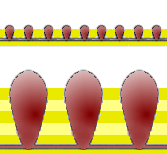
The Rise of Multicellularity
Multicellular organisms are made of many cells that work together, often with different jobs. This evolved many times independently in different groups, like animals, fungi, and plants. This article focuses on organisms with specialized cells.
Being multicellular offered many benefits:
- Better sharing of food.
- More protection from predators.
- Ability to attach to surfaces and resist currents.
- Ability to grow taller to reach sunlight or filter food.
- Creating a protected internal environment.
- Cells working together could act "intelligently."
These new complex organisms also created more varied environments for other life to thrive.
For multicellularity to work well, cells need to cooperate. In sexual reproduction, the genetic mixing helps prevent "rogue" cells from taking over and reproducing on their own. This is why sexual reproduction seems important for complex multicellular life.
Eukaryotes became much more diverse around 1 billion years ago. Sexual reproduction allowed them to create many different forms, with cells specializing in different tasks.
Early Multicellular Fossils
The earliest possible multicellular fossils are the Francevillian biota from 2.1 billion years ago, though this is debated. Another early fossil, Qingshania, from 1.7 billion years ago, seems to have had very similar cells. The red algae Bangiomorpha, from 1.2 billion years ago, is the oldest known organism with clearly specialized cells and is also the oldest known sexually reproducing organism. Fossils from 1.43 billion years ago, thought to be fungi, also show multicellularity with different cell types.
The Emergence of Animals
|
||||||||||||||||||||||||||||||||||||||||||||||||||||
Animals are multicellular eukaryotes that don't have cell walls. Most animals can move, at least at some point in their lives. All animals except sponges have different tissues, like muscles for movement and nerve tissue for sensing and processing information. In 2019, scientists found a 609-million-year-old fossil called Caveasphaera, which might be an early animal or related to the very first animals. This suggests that animal-like development started much earlier than previously thought.
The oldest widely accepted animal fossils are cnidarians (like jellyfish and sea anemones), possibly from around 580 million years ago. Their existence means that the groups leading to jellyfish and to animals with two symmetrical sides had already separated.
The Ediacara biota, which lived just before the Cambrian period, were the first animals to be more than a few centimeters long. Many looked strange, flat, and "quilted." Some have been seen as early molluscs, echinoderms, or arthropods, but their exact classification is still debated. However, Kimberella seems to have been a more complex animal with three cell layers.
Tiny shells from the Early Cambrian period, called small shelly fauna, include early molluscs. Other "armor plates" were later identified as parts of animals like Halkieria and Microdictyon, found in places where soft-bodied animals were also preserved.
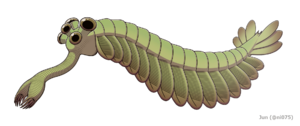
The Cambrian explosion was a time about 530 million years ago when many new animal groups suddenly appeared in the fossil record. Animals like Opabinia from the Burgess Shale were so unusual that they didn't fit into any known group. At first, scientists thought this meant animal evolution was very experimental then. Later, it was realized that many of these "weird wonders" were related to modern groups, like Opabinia being an "aunt" or "cousin" of arthropods. Still, there's a lot of debate about how "explosive" the Cambrian explosion really was and why it happened.
Deuterostomes and the First Vertebrates
Animals are divided into two main groups: protostomes and deuterostomes. Most animals in the Cambrian explosion debate were protostomes. The other group, deuterostomes, includes starfish and sea urchins, as well as chordates (animals with a nerve cord along their back). Many echinoderms have hard shells and are common in Cambrian fossils.
Chordates include soft-bodied animals like tunicates and vertebrates (animals with backbones). While tunicate fossils are older than the Cambrian explosion, fossils like Haikouichthys and Myllokunmingia from China appear to be true early vertebrates. Haikouichthys even had slightly hardened vertebrae. Vertebrates with jaws, like the acanthodians, first appeared in the Late Ordovician period.
Life Moves to Land
Moving from water to land was a huge challenge for life. Land organisms needed ways to avoid drying out, support themselves against gravity, breathe air, and reproduce without water. Although some tiny organisms moved to land much earlier, the first complex land plants and animals appeared in the Ordovician period (488-444 million years ago). Modern land ecosystems, with forests and diverse animals, only appeared much later in the Late Devonian (385-359 million years ago).
In 2017, possible evidence of the earliest life on land was found in Australia, dating back 3.48 billion years, near hot springs. In 2018, scientists reported that bacteria might have lived on land 3.22 billion years ago. And in 2019, a fossilized fungus from a billion years ago was found in the Canadian Arctic, showing fungi were on land long before plants.
How Land Organisms Protected Themselves
Oxygen started building up in Earth's atmosphere over 3 billion years ago. While oxygen is vital for many organisms, it can also cause harmful chemical reactions. Land organisms needed ways to protect themselves from this "oxidative damage." They developed special protective chemicals called antioxidants. For example, brown algae collect mineral antioxidants from seawater.
When plants and animals moved to land about 500 million years ago, they faced a shortage of these marine mineral antioxidants. Land plants slowly developed their own antioxidants, like ascorbic acid (Vitamin C) and polyphenols. Many of these are found in fruits and flowers of modern plants. Animals also developed their own internal antioxidant systems. Iodine is an important antioxidant found in both marine and land organisms.
The Evolution of Soil
Before life colonized land, there was no soil. Land surfaces were just bare rock or sand. Water and nutrients would quickly drain away. It's thought that films of cyanobacteria, similar to those found in modern deserts, were the first organisms to colonize dry land, possibly in the Precambrian. They slowly developed ways to survive drying out as they spread from the sea to land.
Lichens, which are a partnership between a fungus and an alga or cyanobacterium, are also important early colonizers. They can break down rocks, helping to form soil where plants can't grow. The earliest known fungi in lichens are from 423-419 million years ago.
Soil formation sped up with the appearance of burrowing animals, which mix mineral and organic matter. Their waste also adds organic material to the soil. Burrows from worms or arthropods have been found in Ordovician sediments.
Plants and the Devonian Period
In water, most algae cells can photosynthesize and are quite independent. But life on land required plants to become more complex. They needed specialized parts: tops for photosynthesis, roots for water and nutrients, and stems for support and transport.
Spores of land plants, similar to liverworts, have been found in Middle Ordovician rocks from 476 million years ago. By the Middle Silurian (430 million years ago), true plant fossils appeared, including small clubmosses. Many of these were early relatives of vascular plants, which include trees.
By the Late Devonian (370 million years ago), large trees like Archaeopteris were common. They held the soil firmly, changing river systems. This led to a "Late Devonian wood crisis" because:
- Trees removed a lot of carbon dioxide from the atmosphere, reducing the greenhouse effect. This caused an ice age in the Carboniferous period.
- Their deep roots caused more nutrients to wash into rivers and seas. This led to huge growths of algae, which used up oxygen in deeper waters, causing extinctions among deep-water animals.
Land Invertebrates
Animals moving to land had to change how they ate, got rid of waste, and reproduced. Many developed internal fertilization for their eggs. Their eyes also had to adapt to seeing in air instead of water. On the other hand, moving and breathing became easier in air, and hearing developed better.
The oldest animal with signs of air-breathing is Pneumodesmus, a millipede from the Early Devonian (about 414 million years ago). It had spiracles, which are openings for breathing air. However, older tracks from 490 million years ago suggest large, amphibious arthropods were on coastal sand dunes. Other signs of land invertebrates appear in the Late Ordovician. By 415 million years ago, many arthropods were living on coasts and floodplains, and some were eating plants. Arthropods were well-suited for land because their hard outer skeletons protected them from drying out and supported them against gravity.
The fossil record for other invertebrate groups on land is not as clear. The earliest land snails (gastropods) are from the Late Carboniferous, possibly waiting for leaf litter to create the moist conditions they needed.
The first confirmed fossils of flying insects are from the Late Carboniferous, but insects likely developed flight earlier. Flight gave them more places to live, find food, and escape predators. About 99% of modern insect species either fly or came from flying ancestors.
Amphibians
| "Fish" |
|
||||||||||||||||||||||||||||||||||||||||||||||||
Tetrapods, which are vertebrates with four limbs, evolved from fish during the Late Devonian (370-360 million years ago). Early tetrapods, like modern amphibians, still had aquatic tadpole stages.
A hormone called T3 helps amphibians change from water-dwelling tadpoles to land-dwelling frogs. This hormone also helped the evolution of nervous systems in vertebrates.
For a long time, scientists thought tetrapods evolved from fish that could already crawl on land. But in 1987, fossils of Acanthostega from 363 million years ago showed that this animal had legs and both lungs and gills, but it was too weak to live on land. It likely hunted in shallow water. Its skeleton allowed it to lift its head to breathe air while submerged.
The spread of land plants in the Devonian might explain why air breathing was useful. Falling leaves would have created oxygen-poor waters, attracting prey. Air-breathing would have been necessary to hunt in these low-oxygen environments.
There's a gap in the fossil record for about 30 million years after these early tetrapods. After this gap, fossils show vertebrates that were well-adapted for land. Some were early relatives of modern amphibians, which need moist skin and lay eggs in water. Others were early relatives of amniotes, which have waterproof skin and eggs, allowing them to live far from water.
Reptiles
| Amniotes |
|
||||||||||||||||||||||||||||||||||||||||||||||||||||||||||||||||||||||||||||||||||||||||||
Amniotes, whose eggs can survive in dry places, likely evolved in the Late Carboniferous period (around 330 million years ago). The earliest fossils of the two main amniote groups, synapsids and sauropsids, are from about 313 million years ago. Synapsids, including the ancestors of mammals, were common in the Permian period. However, sauropsids and amphibians might have been more common in hotter, drier areas.
The Permian–Triassic extinction event wiped out almost all land vertebrates. After this disaster, which took about 30 million years to recover from, a group of sauropsids called archosauriformes became dominant. Dinosaurs, a type of archosaur, appeared in the Late Triassic and ruled the land during the Jurassic and Cretaceous periods.
Birds
Birds evolved from small, meat-eating theropod dinosaurs during the Late Jurassic. Early birds still had teeth and long, bony tails like their dinosaur ancestors. But by the very Late Jurassic, some had developed beaks, and by the Early Cretaceous, they had short tails.
Mammals
While dinosaurs were dominant, the ancestors of mammals (mammaliaforms) were small, mostly nocturnal insect-eaters. This lifestyle might have helped mammals develop traits like being warm-blooded and having fur. By 195 million years ago in the Early Jurassic, there were animals very similar to modern mammals.
After ruling for about 150 million years, the non-bird dinosaurs died out in the Cretaceous–Paleogene extinction event 65 million years ago. Mammals, which had been limited in size and variety, quickly grew and diversified after this extinction. Bats took to the air within 13 million years, and whales took to the sea within 15 million years.
Flowering Plants
|
|
The first flowering plants appeared around 130 million years ago. Today, there are between 250,000 and 400,000 species of flowering plants, far more than any other land plant. They are the main type of plant in most land ecosystems. Fossils show that flowering plants rapidly diversified in the Early Cretaceous, between 130 and 90 million years ago. Their rise was linked to the evolution of pollinating insects. Scientists are still trying to find the very first stages of flowering plant evolution.
Social Insects
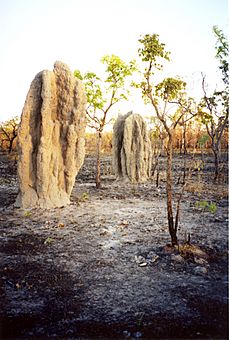
Social insects, like ants and termites, are special because most individuals in a colony are sterile (cannot reproduce). This seems to go against the idea of evolution, where organisms try to pass on their genes. However, there are very few truly social insect species, but they have been incredibly successful. For example, ants and termites make up over 50% of the total weight of all insects, even though they are only about 2% of known insect species. Their ability to control a territory seems to be key to their success.
Scientists used to think that the sterile workers were explained by a special genetic system called haplodiploidy. But now, many believe that social behavior evolved in species facing strong threats from predators and competitors, but in places where they could build safe "fortresses." Once a colony was safe, they gained more advantages by working together to find food.
The earliest insect fossils are from the Early Devonian, about 400 million years ago. By the Late Carboniferous (about 300 million years ago), insects were very diverse and filled many roles as plant-eaters, decomposers, and insect-eaters. Social termites and ants first appeared in the Early Cretaceous. Advanced social bees appeared in the Late Cretaceous but became common in the Middle Cenozoic.
Humans
The idea that modern humans, like other life forms, evolved from ancient ancestors was proposed by Charles Darwin. Modern humans evolved from a line of upright-walking apes that can be traced back over 6 million years to Sahelanthropus. The first known stone tools were made about 2.5 million years ago, possibly by Australopithecus garhi. Early human ancestors had chimpanzee-sized brains, but brain size has quadrupled in the last 3 million years.
There's a debate about whether modern humans evolved all over the world at the same time from existing human-like species, or if they came from a single small population in Africa less than 200,000 years ago and then spread across the globe. Scientists also discuss whether modern humans had a sudden "Great Leap Forward" in intelligence and culture less than 100,000 years ago, and if this was due to changes in the brain.
Mass Extinctions
Life on Earth has experienced several mass extinctions, where many species die out in a relatively short time, since at least 542 million years ago. While these were disasters, they sometimes sped up evolution. When one group of organisms takes over from another in an ecosystem, it's usually not because the new group is "better." Instead, an extinction event often removes the old dominant group, making room for the new one.
The fossil record seems to show that the time between mass extinctions is getting longer, and the normal rate of species dying out is decreasing. This could be for a few reasons:
- The oceans might have become more friendly to life over the last 500 million years. Oxygen spread more widely, and life on land reduced nutrient runoff, which can cause harmful algal blooms in the ocean. Marine ecosystems also became more diverse, making food chains more stable.
- It's hard to find complete fossils, especially from older times. Scientists sometimes mistakenly identify parts of the same ancient organism as different species, which then appear to die out quickly. This might make it seem like more extinctions happened in the past than actually did.
Biodiversity (the number of different types of life) in the fossil record shows a different pattern: it rose quickly from 542 to 400 million years ago, dropped slightly (due to the Permian–Triassic extinction), and then rose quickly again from 200 million years ago to the present.
|
- History of evolutionary thought
- On the Origin of Species
- Speciation
- Taxonomy of commonly fossilised invertebrates
- Treatise on Invertebrate Paleontology
- Viral evolution
See also
 In Spanish: Historia de la vida para niños
In Spanish: Historia de la vida para niños


